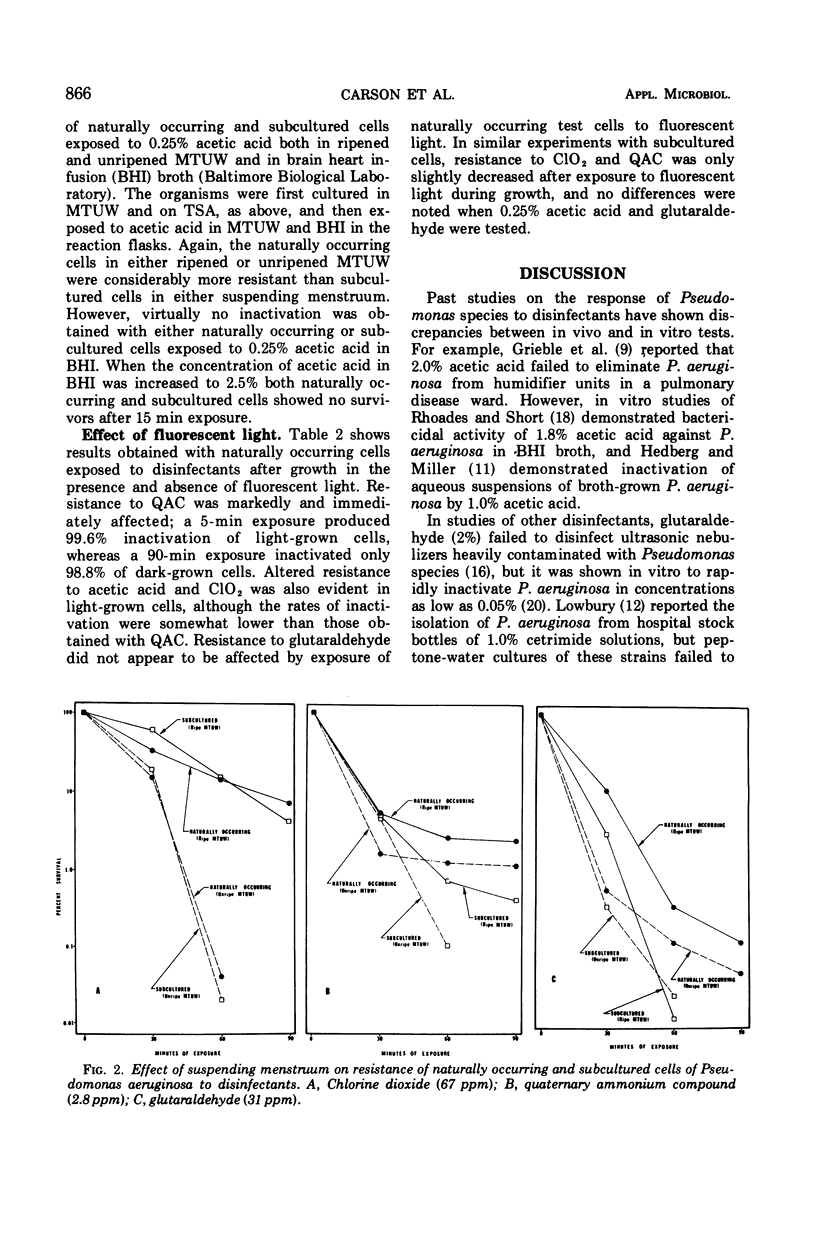Abstract
A strain of Pseudomonas aeruginosa was isolated in pure culture from the reservoir of a hospital mist therapy unit by an extinction-dilution technique; its natural distilled water environment was used as a growth and maintenance medium. After a single subculture on Trypticase soy agar, the strain showed a marked decrease in resistance to inactivation by acetic acid, glutaraldehyde, chlorine dioxide, and a quaternary ammonium compound when compared with naturally occurring cells grown in mist therapy unit water. The following factors were observed to affect the relative resistances of naturally occurring and subcultured cells of the P. aeruginosa strain: (i) temperature at which the cultures were incubated prior to exposure to disinfectants, (ii) growth phase of the cultures at the time of exposure to disinfectants, (iii) nature of the suspending menstruum for disinfectants, and (iv) exposure to fluorescent light during incubation of inocula prior to testing. The applied significance of these findings may alter the present concepts of disinfectant testing as well as routine control procedures in the hospital environment.
Full text
PDF






Selected References
These references are in PubMed. This may not be the complete list of references from this article.
- Adair F. W., Geftic S. G., Gelzer J. Resistance of Pseudomonas to quaternary ammonium compounds. I. Growth in benzalkonium chloride solution. Appl Microbiol. 1969 Sep;18(3):299–302. doi: 10.1128/am.18.3.299-302.1969. [DOI] [PMC free article] [PubMed] [Google Scholar]
- Ayliffe G. A., Collins B. J., Brightwell K. M., Lowbury E. J. Varieties of aseptic practice in hospial wards. Lancet. 1969 Nov 22;2(7630):1117–1120. doi: 10.1016/s0140-6736(69)90716-8. [DOI] [PubMed] [Google Scholar]
- Bassett D. C., Stokes K. J., Thomas W. R. Wound infection with Pseudomonas multivorans. A water-borne contaminant of disinfectant solutions. Lancet. 1970 Jun 6;1(7658):1188–1191. doi: 10.1016/s0140-6736(70)91783-6. [DOI] [PubMed] [Google Scholar]
- Burdon D. W., Whitby J. L. Contamination of hospital disinfectants with Pseudomonas species. Br Med J. 1967 Apr 15;2(5545):153–155. doi: 10.1136/bmj.2.5545.153. [DOI] [PMC free article] [PubMed] [Google Scholar]
- Edmondson E. B., Reinarz J. A., Pierce A. K., Sanford J. P. Nebulization equipment. A potential source of infection in gram-negative pneumonias. Am J Dis Child. 1966 Apr;111(4):357–360. doi: 10.1001/archpedi.1966.02090070055004. [DOI] [PubMed] [Google Scholar]
- Favero M. S., Carson L. A., Bond W. W., Petersen N. J. Pseudomonas aeruginosa: growth in distilled water from hospitals. Science. 1971 Aug 27;173(3999):836–838. doi: 10.1126/science.173.3999.836. [DOI] [PubMed] [Google Scholar]
- Grieble H. G., Colton F. R., Bird T. J., Toigo A., Griffith L. G. Fine-particle humidifiers. Source of Pseudomonas aeruginosa infections in a respiratory-disease unit. N Engl J Med. 1970 Mar 5;282(10):531–535. doi: 10.1056/NEJM197003052821003. [DOI] [PubMed] [Google Scholar]
- Hardy P. C., Ederer G. M., Matsen J. M. Contamination of commercially packaged urinary catheter kits with the pseudomonad EO-1. N Engl J Med. 1970 Jan 1;282(1):33–35. doi: 10.1056/NEJM197001012820108. [DOI] [PubMed] [Google Scholar]
- Hedberg M., Miller J. K. Effectiveness of acetic acid, betadine, amphyll, polymyxin B, colistin, and gentamicin against Pseudomonas aeruginosa. Appl Microbiol. 1969 Nov;18(5):854–855. doi: 10.1128/am.18.5.854-855.1969. [DOI] [PMC free article] [PubMed] [Google Scholar]
- LOWBURY E. J. L. Contamination of cetrimide and other fluids with Pseudomonas pyocyanea. Br J Ind Med. 1951 Jan;8(1):22–25. doi: 10.1136/oem.8.1.22. [DOI] [PMC free article] [PubMed] [Google Scholar]
- Moffet H. L., Allan D., Williams T. Survival and dissemination of bacteria in nebulizers and incubators. Am J Dis Child. 1967 Jul;114(1):13–20. doi: 10.1001/archpedi.1967.02090220019003. [DOI] [PubMed] [Google Scholar]
- Moore B. An outbreak of urinary Pseudomonas aeruginosa infection acquired during urological operations. Lancet. 1966 Oct 29;2(7470):929–931. doi: 10.1016/s0140-6736(66)90535-6. [DOI] [PubMed] [Google Scholar]
- Phillips I., Eykyn S., Curtis M. A., Snell J. J. Pseudomonas cepacia (multivorans) septicaemia in an intensive-care unit. Lancet. 1971 Feb 20;1(7695):375–377. doi: 10.1016/s0140-6736(71)92212-4. [DOI] [PubMed] [Google Scholar]
- Pierce A. K., Sanford J. P., Thomas G. D., Leonard J. S. Long-term evaluation of decontamination of inhalation-therapy equipment and the occurrence of necrotizing pneumonia. N Engl J Med. 1970 Mar 5;282(10):528–531. doi: 10.1056/NEJM197003052821002. [DOI] [PubMed] [Google Scholar]
- Rhoades E. R., Ringrose R., Mohr J. A., Brooks L., McKown B. A., Felton F. Contamination of ultrasonic nebulization equipment with gram negative bacteria. Arch Intern Med. 1971 Feb;127(2):228–232. [PubMed] [Google Scholar]
- Rhoades E. R., Short S. G. Susceptibility of Serratia, Pseudomonas, and Enterobacter to acetic acid. Antimicrob Agents Chemother (Bethesda) 1970;10:498–502. doi: 10.1128/AAC.10.3.498. [DOI] [PubMed] [Google Scholar]
- Roberts F. J., Cockcroft W. H., Johnson H. E. A hot water disinfection method for inhalation therapy equipment. Can Med Assoc J. 1969 Jul 12;101(1):30–32. [PMC free article] [PubMed] [Google Scholar]
- Rubbo S. D., Gardner J. F., Webb R. L. Biocidal activities of glutaraldehyde and related compounds. J Appl Bacteriol. 1967 Apr;30(1):78–87. doi: 10.1111/j.1365-2672.1967.tb00277.x. [DOI] [PubMed] [Google Scholar]
- Simmons N. A., Gardner D. A. Bacterial contamination of a phenolic disinfectant. Br Med J. 1969 Jun 14;2(5658):668–669. doi: 10.1136/bmj.2.5658.668. [DOI] [PMC free article] [PubMed] [Google Scholar]
- Wright D. N., Bailey G. D. Effect of relative humidity on the stability of Mycoplasma pneumoniae exposed to simulated solar ultraviolet and to visible radiation. Can J Microbiol. 1969 Dec;15(12):1449–1452. doi: 10.1139/m69-258. [DOI] [PubMed] [Google Scholar]


